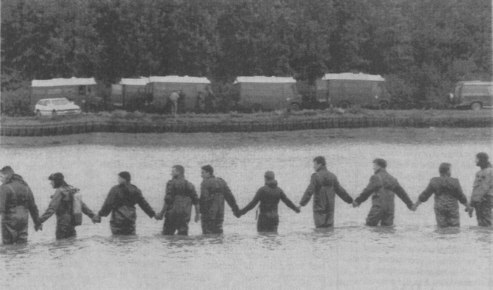
|
Basic Psychology 2Neurotic SuspensionBeyond Kitty Genovese and the Bystander Effect2006, revised 2019SIMON SHEPPARD |
Early in elementary psychology courses the case of Kitty Genovese, murdered in New York in the early hours of 13 March 1964, is often cited. The incident is quoted in support of the notion of ‘Bystander Apathy’ or the ‘Bystander Effect.’
The Genovese case is highly imperfect as an example, for a number of reasons. The incident took place in the middle of the night (3:20am) and an important factor was the necessity (and apparent failure) of witnesses to telephone the police. Invoking authority involves a number of additional mechanisms and there are many extraneous variables in this incident which we would be better off without.

Reports from Rotterdam
A much simpler, and thus better, example of ‘Bystander Apathy’ was reported to have occurred at a Rotterdam boating lake on 21 August 1993 (the incident features in The Tyranny of Ambiguity; 1st ed. fn. p. 250, 2nd ed. p. 395). A Moroccan girl, Naima Quaghmiri, 9 years old, fell out of a boat in the middle of the shallow lake and noisily drowned. The other girl in the boat, a year or two older, tried to hold her above the water but failed, while approximately two hundred spectators watched. One of the crowd even made a video recording of it. As in the Kitty Genovese case, subsequent newspaper articles discussed whether witnesses should be legally obliged to act, or punished for failing to do so.
Since, a contrasting report was found. Apparently the sole source of the report that no-one tried to rescue the drowning girl was the police. They, of course, arrived later.
De Telegraaf 24-08-1993
HELPERS OF DROWNED GIRL FURIOUS AT POLICE
From our Rotterdam Editors
ROTTERDAM, Tuesday
Rotterdam police’s reproach that adult holidaymakers did not lend a hand when a 9-year-old girl drowned in a recreation lake in Barendrecht last Saturday has been contradicted by some day visitors to the park.
Anita Bongers: ‘My friend Jan went into the water immediately after the first cries for help. With four others, he was searching for quite some time.’
‘Because the inflatable boat, in which the two children had sat, was blown by the wind, we did not know exactly where to look,’ says Jan. ‘We scanned the bottom of the approximately two-meter deep water with our feet, but unfortunately nothing was found. That gave a feeling of powerlessness.’
Immediate help
’We are shocked at the reaction of the Rotterdam police that everyone just watched and did nothing. At the time the two girls’ little boat flipped over, it was very quiet around the lake.
‘Yet a number of people were immediately in the water to offer help,’ according to the visitors to the recreation area.
Wim de Rooij, spokesman for the police: ‘Our appreciation goes to those few who took action. However, the fact remains that there were more viewers than helpers. We have heard that and have also found it ourselves.’
One small newspaper report was missed, swamped by all the others which stuck to the narrative that all were omstanders, bystanders. A columnist of the Trouw newspaper even called it “a racist child-murder” and “a murder by omission of a nine-year-old Moroccan girl” (“een racistische kindermoord,” “een moord per omissie op een negenjarig Marokkaans meisje“). This could be an example of a lie travelling around the world before the truth has got its boots on.
Neurotic Suspension
Notwithstanding, the essential mechanism operating in ‘Bystander Apathy’ is Neurotic Suspension: being suspended or frozen in a state of neurotic confusion. (Neurosis is here defined, after Pavlov, as the stress induced when a single stimulus evokes two or more distinct responses.) Neurotic Suspension appears to be particularly strong when collectively expressed, in common with much other crowd behaviour.
The essential conflict here is between responding to the signals, or conforming to what everyone else is doing. Of course doing as others do is what virtually everyone does virtually all the time.
Closely associated with Neurotic Suspension is Response Displacement. Suppose a male has been exposed to excessive female signalling during the preceding months. He is sitting in a library reading, and a female hovers nearby (the Lingering Signal). He not only continues reading, but intensifies his attention on the book, blocking the signalling female from his consciousness.
If a male says something to a female sitting near him at a bar, and she replies not to him but to someone working behind the bar, this is another example of Response Displacement. She has responded not to him but to a neutral third party. Or a plain example is a young female putting her hand over her mouth in response to a friendly comment from a male.
Orthodox psychology would admit that although women are more empathic than men, the latter help more in bystander intervention. I would add that if a male is in a state of Neurotic Suspension, an overt signal from a female, such as a scream or visible expression of fear, is likely to interrupt the suspension and spur him into action. As a society becomes more feminine however, female signals can become more subtle and such overt female expressions may be less likely to occur. If the Neurotic Suspension is extended, there might be displacement activity.
Then we have that Neurotic Suspension is a state of neurotic confusion which can seek resolution in Response Displacement. If Neurotic Suspension is collectively expressed, it will be intensified.
Little-known facets of the Kitty Genovese case
The following may not be significant, the point is that someone else has decided that it is not significant, when it may well be. The following factors are often omitted from the account. That Kitty Genovese was a lesbian (she lived with her lover), her murderer was a Negro necrophiliac, and the area of Kew Gardens, New York was largely Jewish at the time:
A large community of Jewish refugees from Germany took shape in Kew Gardens after the Second World War. The neighborhood attracted many Chinese immigrants after 1965... (Wikipedia).
The author of the original newspaper report was Martin Gansberg. The report was sensational and inaccurate, stating that “for more than half an hour 38 respectable law-abiding citizens... watched a killer stalk and stab a woman” in its opening sentence. The attacks took place at different locations of the block of flats and most of the building’s occupants were in bed. The claim is thoroughly implausible, not least because there not have been 38 people awake at that location at that time of night. It was also physically impossible for them to have watched. The murder did not however take place on the Jewish sabbath (13 March 1964 was a Friday) or else we might have certain Talmudic injunctions complicating the matter yet further.

The induction of psychosis
What then, in light of the above, are the true lessons of the Kitty Genovese case? The incident received wide publicity in 1964 as a supposed indictment of contemporary society. The implicit message, and almost certainly the context in which it was conveyed, was ‘You can be murdered nowadays and no one will come to help.’ Only later was the incident used to construct the concept of ‘Bystander Apathy’ and, as already noted, it is not a very good example.
An explanation is that it was a device to instil fear. Readers of TOA may recall a couple of incidents when females attempted to induce not neurosis, as was usual, but psychosis. Its purpose is to increase suggestibility. A comparable example of the media and government doing this was the ‘millennium mania,’ during which the very real possibility was touted that every device containing a microchip would fail with the change from 1999 to 2000. Computers would freeze, microwave ovens would stop working, airplanes would drop from the sky and so forth. There have been numerous threats of disease epidemics since. They fall under the rubric of ‘scare stories.’
Repeatedly exaggerating dangers, thereby instilling fear of horrors to come, serves to promote heightened nervous stress and detachment from reality, i.e. psychosis. In Britain in the early days of WWII, a “war psychosis” was deliberately engineered to motivate the population to war. During the bombing of Germany, remote and unlikely German towns were chosen as targets purely to inculcate the belief that no-one was safe. It truly was a campaign of “terror-bombing.” Instilling fear makes a population suggestible and more malleable.